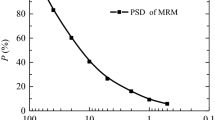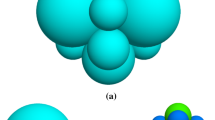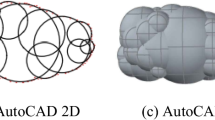This study investigated the microscopic mechanism of coarse-grained soil under triaxial loading using the Particle Flow Code (PFC) – Fast Lagrangian Analysis of Continua (FLAC) coupling method. A numerical model considering the influence of flexible membrane deformation under triaxial loading was established according to the gradation of the material. Then, the validity and reliability of the numerical model were verified by comparison with the laboratory triaxial test results. On this basis, the motion law of particles and the change law of the force chain between the particles were analyzed from the mesoscopic perspective. The coordination number, meso-mechanism of deformation, failure (number of cracks), and energy variation during the loading process were investigated. The deformation mechanism of coarse-grained soil is explained from the mesoscopic perspective: coarse-grained soil mainly depends on a skeleton consisting of particles to bear loads. The deformation of soil is caused by the movement of particles, filling of voids, and change of the particle skeleton structure. The coordination number develops as the axial strain increases. The cracks in the model were mainly shear cracks, which is consistent with the results of the laboratory triaxial test. Finally, the loading process of the coarse-grained soil was closely related to the variation of energy.
Similar content being viewed by others
References
A. Bagherzadeh-Khalkhali and A. A. Mirghasemi, “Numerical and experimental direct shear tests for coarse-grained soils,” Particuology, 7, 83-91 (2009).
J. J. Wang, Y. Yang, and H. J. Chai, “Strength of a roller compacted rockfill sandstone from in-situ direct shear test,” Soil Mech. Found. Eng., 53, 30-34 (2016).
W. Wang, P. He, and D. Zhang, “Finite element simulation based on soil meso-structures extracted from digital image,” Soil Mech. Found. Eng., 51, 17-22 (2014).
N. Benmebarek, H. Labdi, and S. Benmebarek, “A numerical study of the active earth pressure on a rigid retaining wall for various modes of movements,” Soil Mech. Found. Eng., 53, 39-45 (2016).
P. A. Cundall and O. D. L. Strack, “A discrete numerical model for granular assemblies,” Geotech., 29, 47-65 (1979).
A. Bäckström, J. Antikainen, and T. Backers, et al, “Numerical modelling of uniaxial compressive failure of granite with and without saline porewater,” Int. J. Rock Mech. Min. Sci., 45, 1126-1142 (2008).
N. Cho, C. D. Martin, and D. C. Sego, “A clumped particle model for rock,” Int. J. Rock Mech. Min. Sci., 44, 997-1010 (2007).
D. O. Potyondy and P. A. Cundall, “A bonded-particle model for rock,” Int. J. Rock Mech. Min. Sci., 41, 1329-1364 (2004).
J. F. Hazzard and R. P. Young, “Simulating acoustic emissions in bonded-particle models of rock,” Int. J. Rock Mech. Min. Sci., 37, 867-872 (2000).
L. Shao, S. C. Chi, and Y. F. Jia, “Meso-mechanical simulation of a large scale triaxial test of rockfill materials,” Rock and Soil Mechanics, 30, 239-243 (2009).
R. Deluzarche and B. Cambou, “Discrete numerical modelling of rockfill dams,” Int. J. Numer. Anal. Methods Geomech., 30, 1075-1096 (2006).
Itasca Consulting Group, 2015. Particle Flow Code in Three Dimensions: User’s Manual, version 5.0, Minneapolis, USA.
X. Tan, Z. Hu, M. Cao, et al., “3D discrete element simulation of a geotextile-encased stone column under uniaxial compression testing,” Comput. Geotech., 126, 103769 (2020).
M. J. Jiang, J. Zhu, S. Chen, et al., “Experimental study on the approach to predict the shear strength of in-situ sandy gravel,” Soil Mech. Found. Eng., 56, 178-183 (2019).
H. T. Liu and X. H. Cheng, “Discrete element analysis for size effects of coarse-grained soils,” Rock and Soil Mechanics, 30, 287-292 (2009).
G. Q. Cai, S. P. Liu, J. Z. Song, et al., “Insight into relationships between macroscopic and grain-scale parameters in calculating three-dimensional discrete element of unsaturated soils,” Journal of Hunan University (Natural Sciences), 45, 106-112 (2018).
D. O. Potyondy and P. A. Cundall, “A bonded-particle model for rock,” Int. J. Rock Mech. Min., 41, 1329-1364 (2004).
W. Salim and B. Indraratna, “A new elastoplastic constitutive model for coarse granular aggregates incorporating particle breakage,” Can. Geotech. J., 41, 657-671 (2004).
A. B. Kh, A. A. Mirghasemi, and S. Mohammadi, “Numerical simulation of particle breakage of angular particles using combined DEM and FEM,” Powder Technol., 205, 15 (2011).
E. Alaei and A. Mahboubi, “A discrete model for simulating shear strength and deformation behaviour of rockfill material, considering the particle breakage phenomenon,” Granul. Matter, 14, 707-717 (2012).
J. W. Park and J. J. Song, “Numerical simulation of a direct shear test on a rock joint using a bonded-particle model,” Int. J. Rock Mech. Min. Sci., 46, 1315-1328 (2009).
Author information
Authors and Affiliations
Corresponding author
Additional information
Translated from Osnovaniya, Fundamenty i Mekhanika Gruntov, No. 4, July-August, 2023.
Rights and permissions
Springer Nature or its licensor (e.g. a society or other partner) holds exclusive rights to this article under a publishing agreement with the author(s) or other rightsholder(s); author self-archiving of the accepted manuscript version of this article is solely governed by the terms of such publishing agreement and applicable law.
About this article
Cite this article
Zhang, X., Luo, K., Wang, T. et al. Microscopic Mechanism of Coarse-Grained Soil Under Triaxial Test Based on PFC-FLAC Coupling Method. Soil Mech Found Eng 60, 323–329 (2023). https://doi.org/10.1007/s11204-023-09897-w
Published:
Issue Date:
DOI: https://doi.org/10.1007/s11204-023-09897-w




